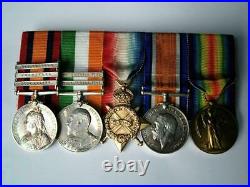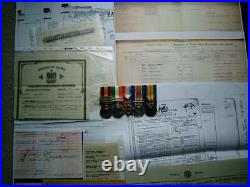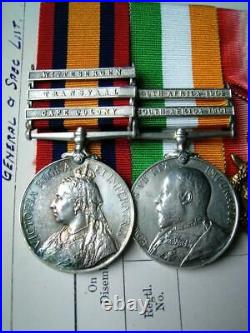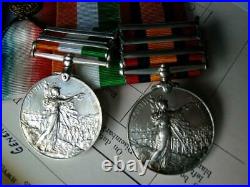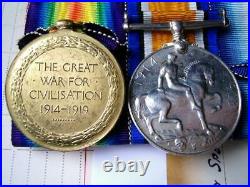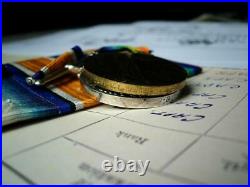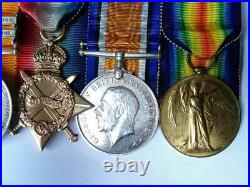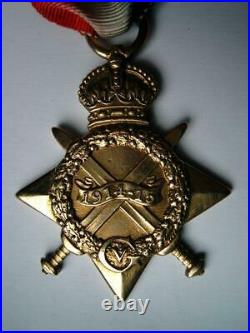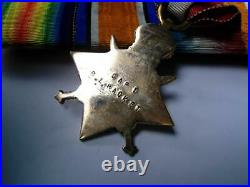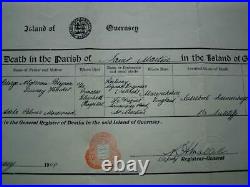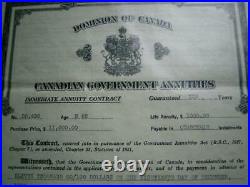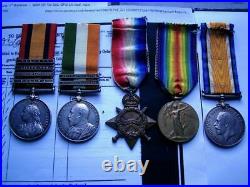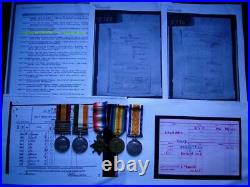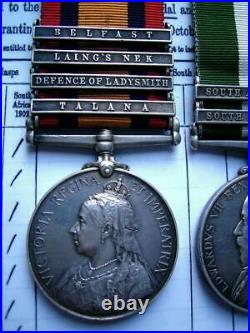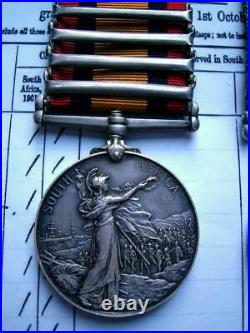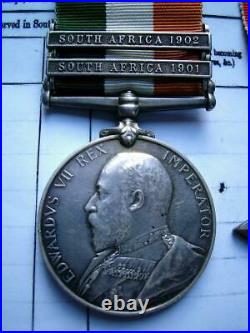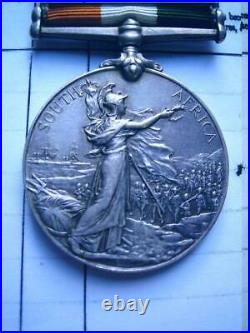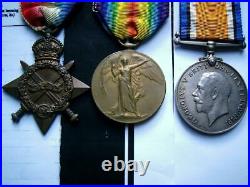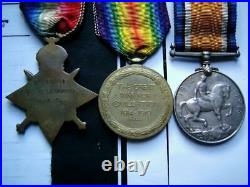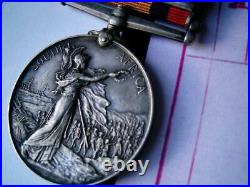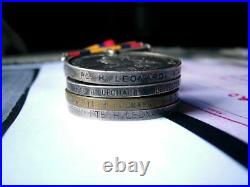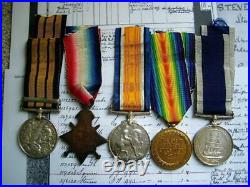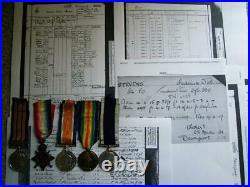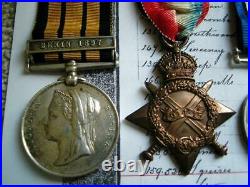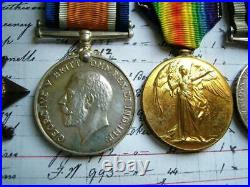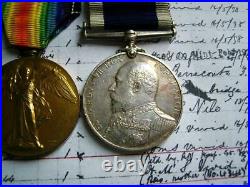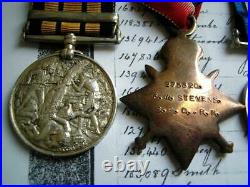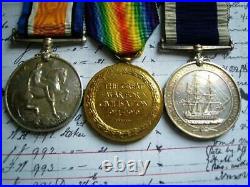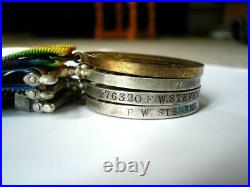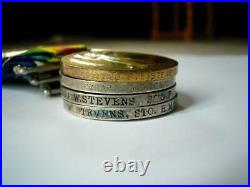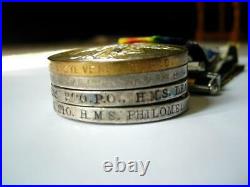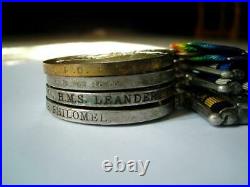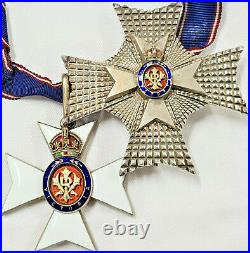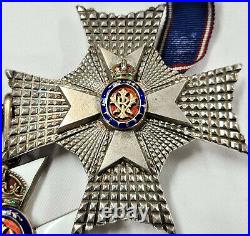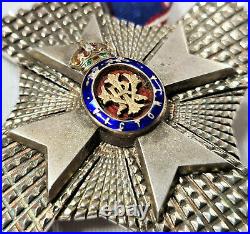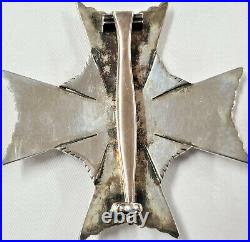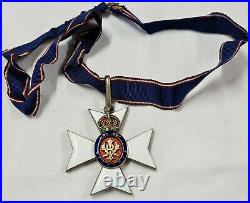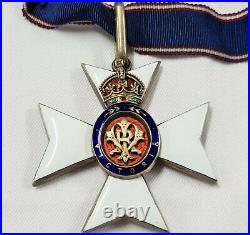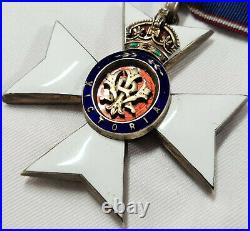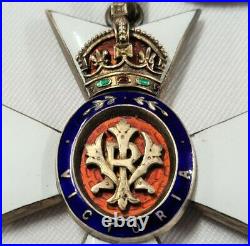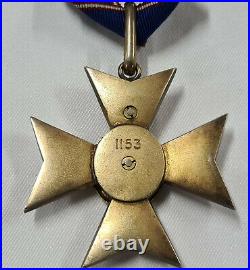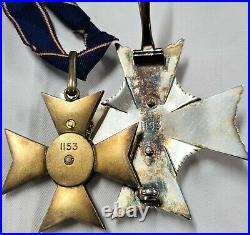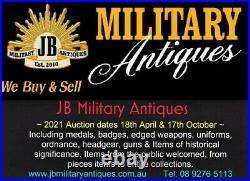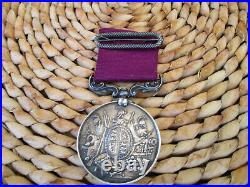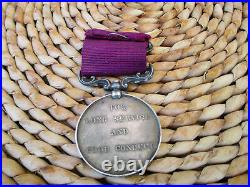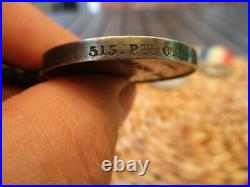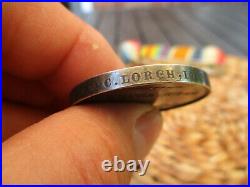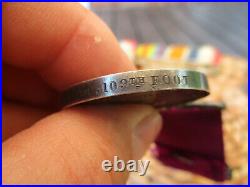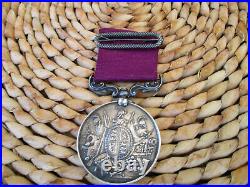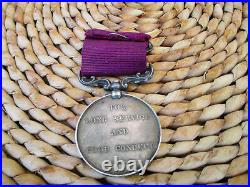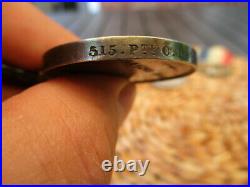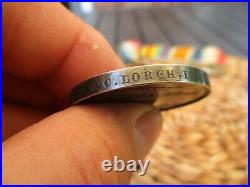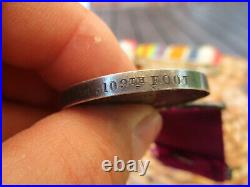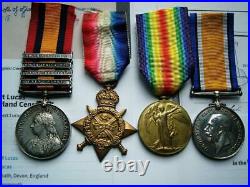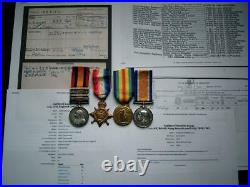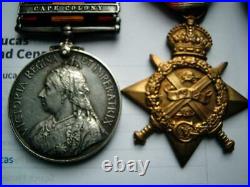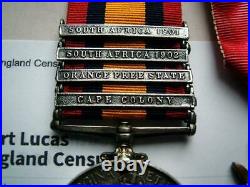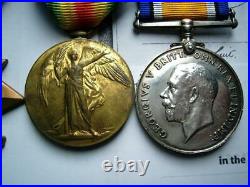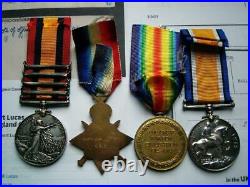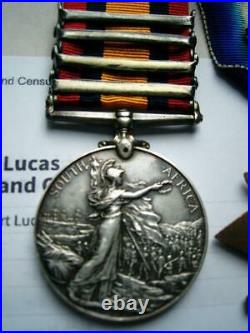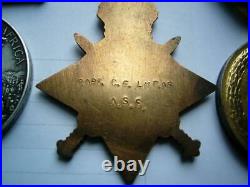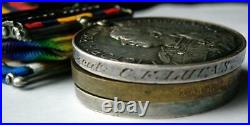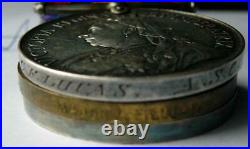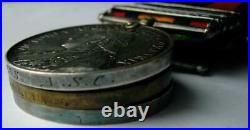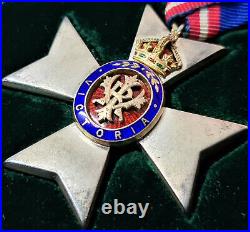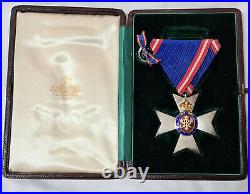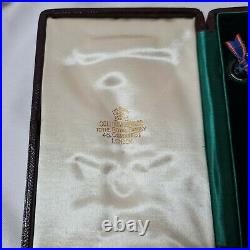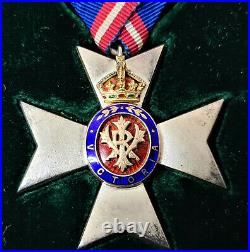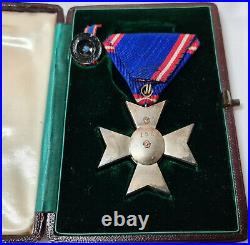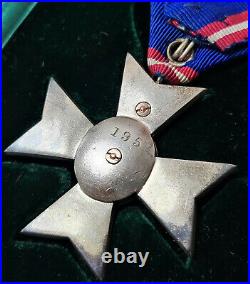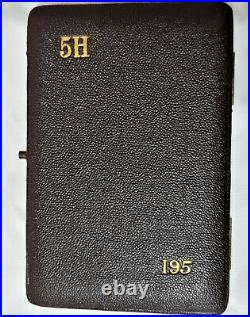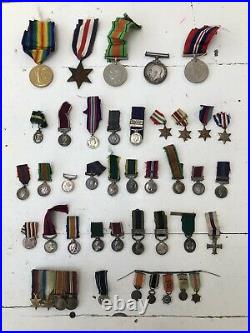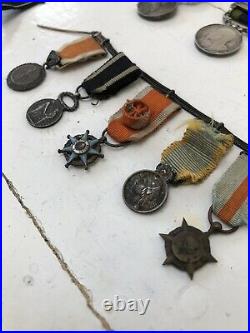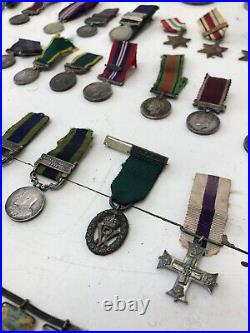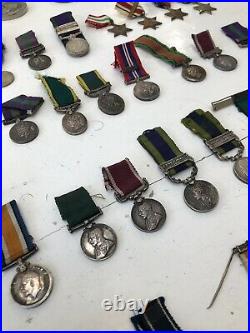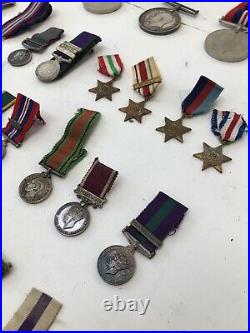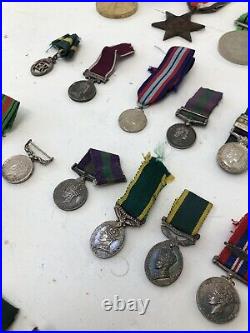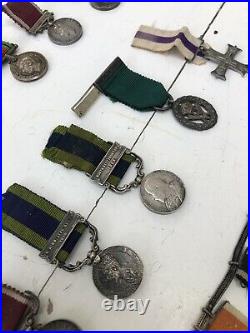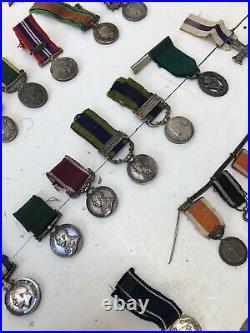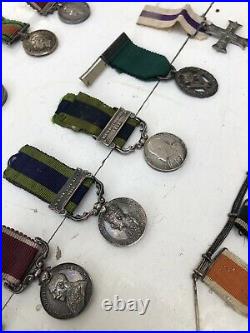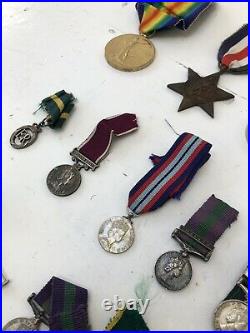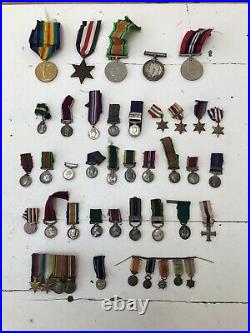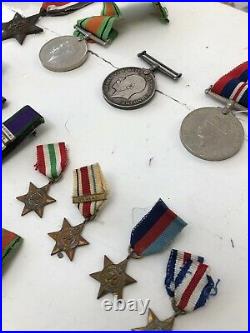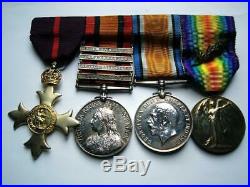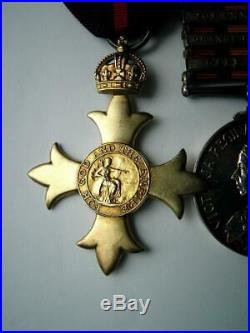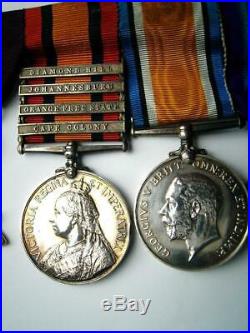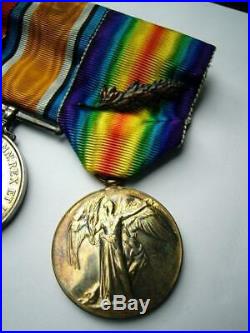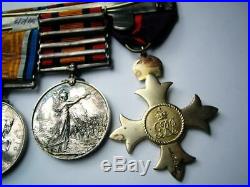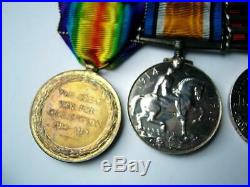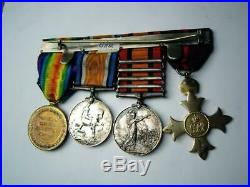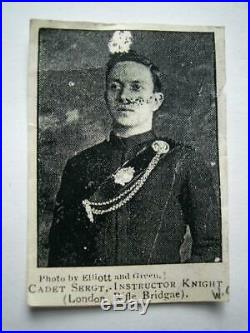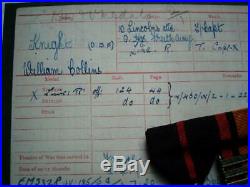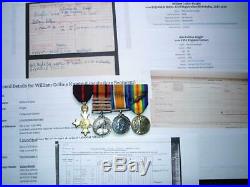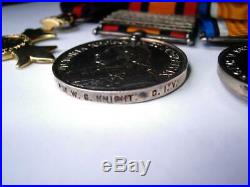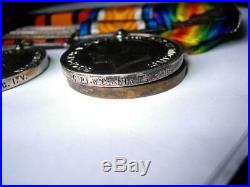- Country/Region of Manufacture: United Kingdom
- Country/ Organization: United Kingdom
- Issued/ Not-Issued: Issued
- Theme: Militaria
- Type: Medals & Ribbons
- Conflict: Boer War (1899-1902)
- Service: Army
- Era: 1816-1913
Posts tagged victorian
Due to the string of defeats during Black Week in December 1899, the British government realized they were going to need more troops than just the regular army to fight the Second Boer War. On 13 December, the decision to allow volunteer forces serve in the field was made, and a Royal Warrant was issued on 24 December. This officially created the Imperial Yeomanry (IY). The Royal Warrant asked standing Yeomanry regiments to provide service companies of approximately 115 men each. In addition to this, many British citizens (usually mid-upper class) volunteered to join the new force. The first contingent of recruits contained 550 officers, 10,371 men with 20 battalions and 4 companies. The first company left Southampton on 31 January 1900, bound for Cape Town, and the whole first contingent arrived in South Africa between February and April. Upon arrival, the IY battalions were sent throughout the zone of operations. The Hampshire Yeomanry raised two service companies for the IY: 41st (Hampshire) Company, which arrived in South Africa on 23 February 1900 and served in 12th Battalion, IY, until 1902 when it transferred to 4th Battalion; and 50th (Hampshire) Company, which landed at Beira, Mozambique, on 4 May 1900 and served with 17th Battalion. In May and June 1900, 12th Battalion, IY, was in Lord Roberts’s army, while the 17th was in Lt-Gen Carrington’s Rhodesian Field Force. The Hampshire IY companies served until 1901, earning the regiment its first Battle honour: South Africa 190001. The Imperial Yeomanry were trained and equipped as mounted infantry. After the Boer War all Yeomanry regiments were termed Imperial Yeomanry until 1907 The battles of 1915 showed both the Allies and the Germans how difficult it was to break through on the Western Front. In most battles, the British and French had around a three-to-one superiority in men and artillery. But, although the German defenders gave ground, they did not break and were often able to retake some of their lost positions. Both side drew lessons from this, the results of which would be demonstrated in the huge attritional struggles of the following year. Victorian Major Hacket Hampshire Imperial Yeomanry QSA KSA Boer war & WW1 medal. 12th Imp: Yeo:”; Kings South Africa 1901-02, 2 clasps, South Africa 1901, South Africa 1902 , official engraved “Lt. “; 1914-15 Star unofficial re-impressed (light signs of previous erasure), British War and Victory Medals official impressed “Capt. , IMO Extremely fine, minimal wear, mounted for display. See pictures for condition Charles Lisle Hacket was born in Rugby, Warwickshire, in 1873, a descendent of the Stuart monarchs of Scotland, and attested for the Imperial Yeomanry at Newport on 8 January 1900, having previously served with the Hampshire Carabineers. He served with the 41st (Hampshire) Company, 4th Battalion, a cavalry unit of the Imperial Yeomanry in South Africa during the Boer War from 31 January 1900, and was commissioned Lieutenant on 8 May 1901, subsequently serving with the Remount Department. He saw further service during the Great War as a Captain on the General List on the Western Front from 25 October 1915, and was promoted Major on relinquishing his commission. In civilian life Hacket had business interests in both Canada and East Africa, and papers included suggest that he was suspected of being guilty of bigamy, with a wife on both continents. He died in Guernsey on 18 January 1949. Imperial Yeomanry mounted Infantry Due to the string of defeats during Black Week in December 1899, the British government realized they were going to need more troops than just the regular army to fight the Second Boer War. After the Boer War all Yeomanry regiments were termed Imperial Yeomanry until 1907 WW1 Western Front The battles of 1915 showed both the Allies and the Germans how difficult it was to break through on the Western Front. Showcase your items with Auctiva’s. Track Page Views With. Auctiva’s FREE Counter. The item “Victorian Major Hacket Hampshire Imperial Yeomanry QSA KSA Boer war & WW1 medal” is in sale since Sunday, November 14, 2021. This item is in the category “Collectables\Militaria\Boer War (1899-1902)”. The seller is “theonlineauctionsale” and is located in England. This item can be shipped worldwide.
Henry Leonard was born at Findern, Northamptonshire in 1875 the son of Thomas and Sarah Leonard. Enlisting on 13 October 1893 with the 2nd Battalion, Leicester Regiment he transferred to the 1st Battalion on 2 January 1896. Posted to South Africa with this unit on 8 January 1896 Leonard served through the Battle of Talana and the Defence of Ladysmith. The Battalion was present for the Battle of Belfast and served throughout the Guerrilla phase of the war. Leonard was transferred to the Depot on 18 August 1902 and posted back to Britain later that year on 13 September. Discharged to the Reserve he served with D Section of the Reserve Battalion from 9 October 1905-9 October 1909 when his period of engagement ended. Having found work as a Labourer he re-attested for the Army Veterinary Corps on 21 July 1915. Leaving Britain for France again on 20 March 1916 he remained there for the duration of the war being placed on furlough between 18 August-1 September 1918. Leonard was discharged on 13 May 1919. Victorian Boer War QSA KSA WW1 medal TALANA DOL LN BELFAST clasp Leicester Regt. Scarce QSA KSA BOER WAR & WW1 medal group with Talana battle clasp. Leonard, I:Leic:Regt”; King’s South Africa 1901-02, 2 clasps, South Africa 1901, South Africa 1902 “3894 Pte H. Leicester: Regt”; 1914-15 Star “Se. “; British War and Victory Medals “Se-10921 Pte. “, all officially named, early version of medal with faint “Ghost dates, IMO Good very fine condition, see pictures for condition, supplied with some service history and medal roll copies. Start of the 2ND Boer war “TALANA HILL” October 1899. The 1st Battalion Leicester Regiment was stationed at Glencoe, in the north of Natal, when the war broke out. It thus formed part of the brigade of General Penn Symons, the other battalions being the 1st King’s Royal Rifles, 1st Royal Irish Fusiliers, and 2nd Dublin Fusiliers. There were also at Glencoe the 18th Hussars and the 13th, 67th, and 69th Batteries RFA. The troops were soon set in motion. To the Leicesters and 67th Battery was assigned the duty of guarding the camp with its great quantities of stores. The general decided to attack with his other infantry and artillery. These moved away and were soon in extended order advancing to a wood, which the commander had decided to use as a breathing place. About 8.50 the infantry again advanced, and as they left the wood had to face a terrible rifle-fire both from their front and flank. Sir W Penn-Symons, who had been exposing himself with rash bravery, fell mortally wounded about 9.30; Brigadier General Yule, now in command, directed the infantry to move to a wall stretching some distance along the hillside, from which wall a very heavy fire was being kept up by the Boers. The two batteries redoubled their efforts. The 1st King’s Royal Rifles on the right first reached the wall, followed by some companies of the Irish Fusiliers; the Dublin Fusiliers also made their way up a little later. After another breathing space under cover of the wall the troops jumped the wall and scrambled up the steep face. Then followed the first blackguardly use of the white flag. Within easy range of our artillery were to be seen clumps of 50 and 100 men on which guns could have inflicted great loss. The enemy, however, displayed a white flag, although they do not appear to have had any intention of surrendering, and in consequence the officer commanding Royal Artillery refrained from firing. One can scarcely acquit this officer from being very easily taken in, as the enemy’s continued movement contradicted any idea of surrender. The infantry had done magnificently; the same cannot be said of the Hussars, or at least those under Colonel Moller, who managed to get lost among the enemy, and was taken prisoner with 200 men. The artillery did well, but it seems beyond doubt that they fired at the hill-top after it was occupied by our people, causing some loss, particularly to the King’s Royal Rifles. The range was short, and artillery officers with proper glasses should have seen when the British troops were up. The Leicesters lost 1 officer killed, 1 wounded, and 1 man wounded. Leicester regiment mounted infantry. On the 21st General Yule moved his camp to a better position. On the 22nd he resolved to retreat on Ladysmith. At nine at night in silence, without bands or pipers, the force set out by the east or Helpmakaar road, the dying general, the other wounded, and the doctors being left. A great mass of stores had also to be left to the enemy, as its destruction would have made him suspect the intended retreat; while, on the other hand, a twelve hours’ start was absolutely necessary. To have fought their way to Ladysmith would have been an impossible task for Yule’s column in that hilly country. As it was, the Boers showed that inexplicable want of energy which seemed at times in the campaign to paralyse them. Probably the good things left in Dundee had something to do with the lack of activity. Fortunate it was that General Yule was not interfered with by the enemy, but the elements were not favourable. The rain at times fell in torrents; roads knee-deep in mud and swollen spruits made marching very heavy work, while but little sleep was obtainable between the 21st and 26th. On the 30th, in the battle of Ladysmith (Defence and later relief), the Leicesters were with Colonel Grimwood on the right and had a very trying day. They had about 24 casualties. After the siege began the Leicesters occupied posts on the north side, and they were not much pressed in the great attack on 6th January 1900. For their work during the siege 2 officers and 3 men were mentioned in Sir George White’s despatch of 23rd March 1900. When the Boers retreated Spring 1900 from natal, every bridge, culvert, reservoir and railway was a target to be destroyed including Lang’s Nek tunnel. The rapid British advance of Spring 1900 prevented the Boers from damaging the tunnel to the extent they wished. They hurriedly dynamited the two entrances to the tunnel before Lord Dundonald and his troops occupied the position May 1900. British discovered the tunnel was not badly damaged and quickly cleared the rubble from the line. This allowed the trains to supply the British advance into the Orange Free State and Transvaal. Lang’s Nek tunnel blocked by explosion made by the Boers may 1900. When, Ladysmith having been relieved and its garrison recuperated, Sir Redvers Buller moved north, the Leicesters were brigaded with the 1st Liverpool, 1st Royal Inniskilling Fusiliers, and 1st King’s Royal Rifles. They were present at Bergendal (Battle of Belfast) and many other actions, but had a remarkable immunity from mishaps and heavy casualty lists. In his despatch of 10th October 1900 Lord Roberts mentions that in the operations about Badfontein on the way to Lydenburg the Leicesters and 1st King’s Royal Rifles pulled a field battery up a steep hill, which did much to assist in compelling the enemy to bolt. Seven officers and 9 non-commissioned officers and men of the battalion were mentioned in General Buller’s despatch of 9th November 1900, and 11 officers and 12 non-commissioned officers and men were mentioned by Lord Roberts in his final despatch. After marching to Lydenburg with General Buller, and taking part in his other operations north of the Delagoa line, the Leicesters remained in the Eastern Transvaal, sometimes trekking, as in General French’s operations, sometimes doing garrison duty. That their work was consistently good is proved by the fact that they got rather more than an average number of mentions in Lord Kitchener’s despatches during the war. For a long time prior to the close of the war they occupied blockhouses on the Standerton-Ermelo road. In the final despatch 4 officers and 6 non-commissioned officers were mentioned. RVC working on an injured horse WW1. During the First World War almost half the veterinary surgeons in Britain served as officers in the AVC, and the number of other ranks in the Corps grew from 934 to 41,755. Innovations included provision of Mobile Veterinary Sections, to transfer sick and wounded horses to veterinary hospitals, and camel specialists, who staffed hospital facilities in Egypt. As well as serving on the Western Front, the AVC was deployed with animals to such contrasting theatres of war as Gallipoli, Salonika, Mesopotamia and Palestine. In 1918 the Corps was given its Royal prefix in recognition of its service through the First World War. At the time the Quartermaster-General wrote. The Corps by its initiative and scientific methods has placed military veterinary organisation on a higher plane. The high standard which it has maintained at home and throughout all theatres has resulted in a reduction of animal wastage, an increased mobility of mounted units and a mitigation of animal suffering un-approached in any previous military operation. Hundreds of thousands of horses died during WW1, due to disease, injury, starvation and shelling, they became in very short supply by 1917, considered more valuable than a soldier as they were essential for logistical work, pulling large loads through difficult terrain, mud and shell holes made it almost impossible to use mechanised vehicles. Demobilisation in 1919 after the war was followed by mechanisation, and consequentially the RAVC was greatly reduced in size. Auctiva gets you noticed! Track Page Views With. Auctiva’s FREE Counter. The item “Victorian Boer War QSA KSA WW1 medal TALANA DOL LN BELFAST clasp Leicester Regt” is in sale since Saturday, December 4, 2021. This item is in the category “Collectables\Militaria\Boer War (1899-1902)”. The seller is “theonlineauctionsale” and is located in Offchurch. This item can be shipped worldwide.
- Country/Region of Manufacture: United Kingdom
- Country/ Organization: United Kingdom
- Issued/ Not-Issued: Issued
- Theme: Militaria
- Type: Medals & Ribbons
- Conflict: Boer War (1899-1902)
- Service: Army
- Era: 1816-1913
Frederick William Stevens was born in Kingstown, Dublin, on 3 November 1874, and joined the Royal Navy as a Stoker Second Class on 13 March 1894. He served in H. Philomel from 1 December 1894 to 17 March 1897, and was promoted Stoker on 1 August 1896. Advanced Stoker Petty Officer on 1 July 1906, he was awarded his Long Service and Good Conduct Medal on 5 May 1909. Start of WW1 was serving aboard HMS Bellona, a sout cruiser. Admitted to the Royal Naval Hospital at Plymouth as a dangerous lunatic on 31 March 1915, he was invalided out of the service to pension on 5 April of that year. Pension card shows he was discharged from asylum in April 1917. (supplied with medal roll extracts and service record). HMS Philomel Ashanti Benin 1897 WW1 trio LS&GC medal SPO Stevens RN from Dublin. East & West Africa CAMPAIGN MEDAL 1897 Benin, HMS Philomel. (supplied with medal roll extracts and service record) HMS Philomel – Cruiser In mid 1892 Philomel deployed to the Cape of Good Hope Station, where it would spend the, next six years. This punitive expedition resulted from several men being killed or wounded when a Government boat was fired upon in August. Captain Charles Campbell of Philomel led one detachment of seamen in an attack on the principal town, where there was no opposition but 106 guns were captured, as was the chiefs treasury. Recommissioning on station in August 1894, Philomel participated in the M wele Expedition in August 1895 and the Bombardment of Zanzibar in August the following year. The latter resulted from a prince trying to usurp the throne on the death of the Sultan. Britain, with the acquiescence of the other European embassies, supported the true heir. After 37 minutes of bombardment of the Sultans palace, the rebels left and the rightful successor was proclaimed. In January 1897 the British Consul General in Niger was attacked and the following month an expedition was mounted to Benin to arrest those responsible. Personnel from Philomel formed part of the Naval Brigade and during the attack the ships Captain and the Gunner were wounded. Plundered Ivory, Bronzes, sculptures etc Most of the plunder from the city was retained by the expedition with some 2,500 (official figures) religious artefacts, Benin visual history, mnemonics and artworks being sent to England. The British Admiralty confiscated and auctioned off the war booty to defray the costs of the Expedition. The expected revenue from the expedition was discussed already before Phillips set out on his ill-fated journey to the city of Benin in 1896. In a letter to Lord Salisbury, the British Foreign Secretary, Phillips requested approval to invade Benin and depose the Oba, adding the following footnote: I would add that I have reason to hope that sufficient ivory would be found in the King’s house to pay the expenses incurred in removing the King from his stool. European Modernist movement pictures influenced by Benin African art- including Picasso The dispersal of the Benin art to museums around the world catalysed the beginnings of a long and slow European reassessment of the value of West African art. The Benin art was copied and the style integrated into the art of many European artists and thus had a strong influence on the early formation of modernism in Europe. King of Benin The King of Benin was eventually captured by the British consul-general, Ralph Moor. He was deposed and sent to live out his days in Calabar. He died in 1914. HMS Bellona – Bodicea class scout cruiser He served at the start of WW1 with HMS Bellona was one of two Boadicea-class scout cruisers built for the Royal Navy in the first decade of the 20th century. Bellona spent the bulk of World War I with that squadron, He transferred to shore establishment Vivid II January 1915 but invalided to Insane assylum in April 1915. Pension record card shows he was discharged from hospital April 1917. Create your brand with Auctiva’s. Attention Sellers – Get Templates Image Hosting, Scheduling at Auctiva. Track Page Views With. Auctiva’s FREE Counter. The item “Victorian HMS Philomel Ashanti Benin 1897 WW1 LS&GC medal SPO Stevens RN Dublin” is in sale since Friday, July 23, 2021. This item is in the category “Collectables\Militaria\19th Century (1800-1899)\Medals/ Ribbons”. The seller is “theonlineauctionsale” and is located in England. This item can be shipped worldwide.
- Type: Medals & Ribbons
- Issued/ Not-Issued: Issued
- Conflict: East & West Africa Benin 1897
- Era: 1816-1913
- Country/ Organization: United Kingdom
- Time Period: 19th Century (1800-1899)
- Theme: Militaria
- Service: Navy
- Country/Region of Manufacture: United Kingdom
Offered is an original and rare set of The Royal Victorian Order, K. Knight Commanders set of insignia, comprising neck badge and breast star. Matching set, both set in silver-gilt and enamels and officially numbered 1153. The neck badge measuring 51mm wide, with near flawless white enamel cross arms, solid gold VR cypher, on red enamel background, surmounted by a blue enamel border, with gilt & enamel tudor crown. Reverse shows the gilt finished plain reverse, locking bolts and suspension ring, with dress ribband, retaining clip ties. The 72mm wide breast badge of same design to centre as the neck badge, slight rubbing to blue enamel field, being fitted onto a cut breast star base. Wide tapered pin to rear, showing toning overall. The Royal Victorian Order, K. Knight Commanders set of insignia is the 2nd highest grade of the order, being seldonly seen for sale. The Royal Victorian Order is a dynastic order of knighthood established in 1896 by Queen Victoria. It recognises distinguished personal service to the monarch of the Commonwealth realms, members of the monarch’s family, or to any viceroy or senior representative of the monarch. The present monarch, Queen Elizabeth II, is the sovereign of the order, the order’s motto is Victoria, and its official day is 20 June. The order’s chapel is the Savoy Chapel in London. All international items/combined orders will be sent via registered post international, via Australia Post, without exception. We list militaria and coins weekly. We provide quality mounted medals, badges and historical research. We can mount your miniature or full size medals, ribbon bars or supply replacement ribbons or badges. We can also conduct military research on your behalf and value cherished objects with a current market or insured value. We run two specialist military auctions per year. Items are accurately described & photographed. Additional costs for this standard service will be added for this service based on publicly available Australia Post rates. Please note, these items are located and will be posted from Australia. We appreciate fair feedback from you once you receive the item. We aim to give you, the customer our best customer service. The item “RARE WW1 WW2 BRITISH ROYAL VICTORIAN ORDER NECK BADGE & STAR #1153 MEDAL KCVO” is in sale since Monday, July 26, 2021. This item is in the category “Collectables\Militaria\1914 – 1918 (WWI)”. The seller is “jb_military_antiques_14″ and is located in 2/135 Russell St, Morley, Perth, WA. This item can be shipped worldwide.
- Modified Item: No
- Campaign: World War I
- Theme: Militaria
- Product Type: Medals
- Original/Reproduction: Original
- Era: 1900s
- Country: Britain
A NICE VICTORIAN LSGC MEDAL 515 pte c lorch 109th foot. FEEL FREE TO ASK ANY QUESTIONS TO ASK ANY QUESTIONS. The item “WW1 VICTORIAN BRITISH MEDAL” is in sale since Thursday, June 17, 2021. This item is in the category “Collectibles\Militaria\WW I (1914-18)\Original Period Items\Great Britain\Medals, Pins & Ribbons”. The seller is “scooopers” and is located in Manhasset, New York. This item can be shipped worldwide.
A NICE VICTORIAN LSGC MEDAL 515 pte c lorch 109th foot. FEEL FREE TO ASK ANY QUESTIONS TO ASK ANY QUESTIONS. The item “WW1 VICTORIAN BRITISH MEDAL” is in sale since Monday, June 7, 2021. This item is in the category “Collectibles\Militaria\WW I (1914-18)\Original Period Items\Great Britain\Medals, Pins & Ribbons”. The seller is “scooopers” and is located in Manhasset, New York. This item can be shipped worldwide.
Cuthbert Forrestier Lucas born Teignmouth, Devon, 1879. He is promoted prior to Captain WW1, served with British Expeditionary force from August 1914 earning 1914 Star, promoted to Major about October 1915 and served until retirement in February 1921 aged about 42. He was living in Bulls Barn, Ditching Common, Chailey, Sussex when he died in 1962 aged about 82. Victorian Major Lucas ASC QSA Boer war WW1 1914 Star Victory war medal Fr Devon. , IMO very fine condition, has replacement suspension and clasps are taylors copies. WW1 trio, 1914 Star has re-impressed name CAPT C. ” , Victory Medal has official impressed name ” MAJOR C. LUCAS and British war medal is neatly erased, WW1 trio otherwise generally very fine, see pictures for condition. Supplied with QSA medal roll extract confirming medal and clasps , copy WW1 medal index card, some promotion lists and family census details. WW1 Western Front He is promoted prior to Captain WW1, served with British Expeditionary force from August 1914 earning 1914 Star, promoted to Major about October 1915 and served until retirement in February 1921 aged about 42. Auctiva gets you noticed! Track Page Views With. Auctiva’s FREE Counter. The item “Victorian Major Lucas ASC QSA Boer war WW1 1914 Star Victory war medal Fr Devon” is in sale since Sunday, April 4, 2021. This item is in the category “Collectables\Militaria\Boer War (1899-1902)”. The seller is “theonlineauctionsale” and is located in England. This item can be shipped worldwide.
- Type: Medals & Ribbons
- Issued/ Not-Issued: Issued
- Conflict: Boer War (1899-1902)
- Era: 1816-1913
- Country/ Organization: United Kingdom
- Theme: Militaria
- Service: Army
- Country/Region of Manufacture: United Kingdom
Offered is a Royal Victorian Order, 5th Class, Members Breast Badge M. , unusually being awarded to a foreign national, before the First World War. A fine silver and enamel example, the reverse officially numbered 195, (believed to be issued about 1902 – being a very early award) the ribbon worn in the continental manner (signifying that it would have been awarded to a foreign national) with button hole award ribbon for civilian wear. Housed in it’s Collingwood (by Appointment to the Royal Family) fitted green velvet and cream silk lined case of issue, with quality gilt embossed’5H’ and’195′ to underside of case. We list militaria and coins weekly. We provide quality mounted medals, badges and historical research. We can mount your miniature or full size medals, ribbon bars or supply replacement ribbons or badges. We can also conduct military research on your behalf and value cherished objects with a current market or insured value. We run two specialist military auctions per year. Items are accurately described & photographed. Additional costs for this standard service will be added for this service based on publicly available Australia Post rates. Please note, these items are located and will be posted from Australia. We appreciate fair feedback from you once you receive the item. We aim to give you, the customer our best customer service. The item “PRE WW1 C. 1902 ROYAL VICTORIAN ORDER 5TH CLASS MEDAL #195 CASED FOREIGN AWARD” is in sale since Thursday, April 29, 2021. This item is in the category “Collectables\Militaria\1914 – 1918 (WWI)”. The seller is “jb_military_antiques_14″ and is located in 2/135 Russell St, Morley, Perth, WA. This item can be shipped worldwide.
- Modified Item: No
- Campaign: World War I
- Theme: Militaria
- Original/Reproduction: Original
- Country: Britain
- Product Type: Medals
- Era: 1900s
Vintage Military Medals – a collection of 44 medals, miniature and real size. Era: Victorian, Edwardian, WW1, WW2, and Post War. Theyre all British except for the ones at the bottom… To be very honest, I dont know anything about military medals, but I was told the French ones are very rare in this condition. I bought all these medals about 15 years ago. Hope they find good home. The item “Vintage Military Medals Victorian, Edwardian, WW1, WW2, Post War Set Of 44″ is in sale since Sunday, September 27, 2020. This item is in the category “Collectables\Militaria\World War I (1914-1918)\Medals/ Ribbons”. The seller is “jentlemanship” and is located in London. This item can be shipped worldwide.
- Type: Medals & Ribbons
- Conflict: World War I (1914-1918)
- Issued/ Not-Issued: Issued
- Service: Army
- Modified Item: No
- Featured Refinements: Military Medal
- Era: 1914-1945
IMO Very fine condition plus, OBE, Mentioned in dispatches medal group awarded to Major William Collins Knight. The Most Excellent Order of the British Empire, O. ; British War and Victory Medals, with M. Oak leaves, official impressed, Capt. WW1 served in the 10th Lincolnshire Regt, “Grimsby Chums”, Slight wear, few minor marks, light bruise to QSA, Very fine or better. Promoted Major when awarded OBE. Major Knight WW1 OBE MID Victorian QSA City London Volunteer War & Victory medal. Boer War WW1 OBE MID British War & Victory medals Major Knight City of London Volunteers & Lincolshire Regt IMO Very fine condition plus, OBE, Mentioned in dispatches medal group awarded to Major William C Knight. WW1 served in 10th Btn Lincolnshire Regt, “Grimsby Chums”, Slight wear, few minor marks, light bruise to QSA, Very fine or better. London Gazette 3 June 1919: For valuable service rendered in connection with military operations in France William Collins Knight was born in Wandsworth, London in 1878, Father William Thomas Knight and Mother Georgiana Northmore Knight, he had one older sister and four younger brothers (1891 census). He joined the 1st City of London Rifle Volunteers in 1896 and was a Cadet Sergeant-Instructor in that unit, while civilly employed as a clerk in the drapery trade, when he volunteered for the City of London Imperial Volunteers in 1900. He served in the Infantry Battalion of the C. During the Boer War. An article in the City Press, 14 November 1900, reports on a dinner for 6 returning C. In 1906 he married Lilly Warren in Wandsworth, London. In the 1911 census they were living in Streatham, London, had a daughter aged 2 and servant. Following the outbreak of the Great War, Knight was commissioned Temporary Lieutenant in the 9th (Reserve) Battalion (aged about 35), Lincolnshire Regiment on 10 December 1914 and promoted Temporary Captain, attached 10th Battalion, Lincolnshire Regiment ” Grimsby Chums”, on 1 April 1916, serving on the Western Front from 2 April 1917. Staff, Fourth Army, he was Mentioned in Field Marshal Haigs Despatch of 16 March 1919 (London Gazette 8 July 1919), promoted to Major and for his services during the Great War was appointed an Officer of the Order of the British Empire. He died in 1936 aged 58, recorded Battersea, London. Paperwork of history included, medal index card WW1 for WW1 pair, OBE & MID, medal roll extract for QSA, not entitled KSA. BATTLE OF DIAMOND HILL. This took place on 11 and 12 June 1900 during the Second Boer War. Fourteen thousand British soldiers squared up against four thousand Boers and forced them from their positions on the hill. The British cavalry were under the command of Sir Ian Hamilton. He despatched Robert Broadwood’s 2nd Cavalry brigade, which included the 10th Royal Hussars, 12th Royal Lancers and the Household Cavalry Regiment, on a Special Mission. As the sun came up it was a bitterly cold Monday morning… We are hidden in the hills at Donkerhoek… Confided Botha to his diary. As a detachment of 10th Hussars swung off to the right, they were attacked from Diamond Hill. A section of Q Battery RHA attempted to return artillery fire, but had no infantry support, until the 12th Lancers arrived on the front line. The Boers pressed the matter hard. Two squadrons of Household Cavalry Regiment and one squadron of the 12th Hussars charged at full gallop at Boers firing from concealed positions. On 13th the Botha’s army retreated to the north, they were chased as far as Elands River Station, only 25 miles from Pretoria, by Mounted Infantry and De Lisle’s Australians. Forty-four years after the battle, British General Ian Hamilton opined in his memoirs that “the battle, which ensured that the Boers could not recapture Pretoria, was the turning point of the war”. Hamilton credited Winston Churchill with recognizing that the key to victory would be in storming the summit, and risking his life to signal Hamilton. Lincolnshire Regiment 9th (Reserve) Battalion (December 1914 to April 1916) Formed in Lincoln in November 1914 as Service battalion, part of K4. November 1914 : came under command of 91st Brigade, original 30th Division. February 1915: moved to The Hayes, Swanwick in Derbyshire. 10 April 1915 : became a reserve battalion. Lincolnshire Regiment 10th (Service) Battalion (Grimsby) (April 1916 to April 1917) Often known by its original name of the Grimsby Chums. Formed at Grimsby on 9 September 1914 by the Mayor and Town. June 1915 : came under command of 101st Brigade, 34th Division. FOURTH ARMY HQ movements (April 1917 – 1919) 15 April 1917: Villers Carbonnel 5 July 1917: Malo-les-Bains 25 October 1917 : Rosendael (Dunkirk) 5 November 1917 : Dury 9 November 1917: staff and HQ of Fourth Army takes over from Second Army at Cassel. On 20 December 1917 what had been Second Army was renamed as Fourth Army. On 13 March 1918 the units under Fourth Army were placed under command of the reconstituted Second Army and four days later what had been Fourth Army was renamed as Second Army. 22 March 1918 : Querrieu 25 March 1918 : Picquigny-sur-Somme 27 March 1918 : Abbeville. Next day, Fourth Army took over command of Fifth Army. The latter ceased to exist on 2 April 1918. 30 March 1918 : Auxi-le-Chateau 31 March 1918 : Flixecourt 2 April 1918 : Dury 5 April 1918 : Flixecourt. 30 August 1918 : Bertangles 25 September 1918 : Eterpigny 14 October 1918 : Montigny Farm (Roisel, HQ located in a train) 3 November 1918 : Honnechy (in a train) 16 November 1918 : Avesnes 30 November 1918 : Ham-sur-Heure 10 December 1918 : Namur. FOURTH ARMY BATTLES WW1 from April 1917 Pursuit of the German retreat to the Hindenburg Line (March-April 1917) The Battle of Amiens (August 1918) The Second Battles of the Somme 1918 (August-September 1918) The Battles of the Hindenburg Line (September-October 1918) The final advance in Picardy (October-November 1918). Create your brand with Auctiva’s. Attention Sellers – Get Templates Image Hosting, Scheduling at Auctiva. Track Page Views With. Auctiva’s FREE Counter. The item “Major Knight WW1 OBE MID Victorian QSA City London Volunteer War & Victory medal” is in sale since Tuesday, August 25, 2020. This item is in the category “Collectables\Militaria\19th Century (1800-1899)\Medals/ Ribbons”. The seller is “theonlineauctionsale” and is located in Offchurch. This item can be shipped worldwide.
- Country/Region of Manufacture: United Kingdom
- Country/ Organization: Great Britain
- Issued/ Not-Issued: Issued
- Type: Medals & Ribbons
- Conflict: Boer War (1899-1902)
- Service: Army
- Era: 1816-1913
